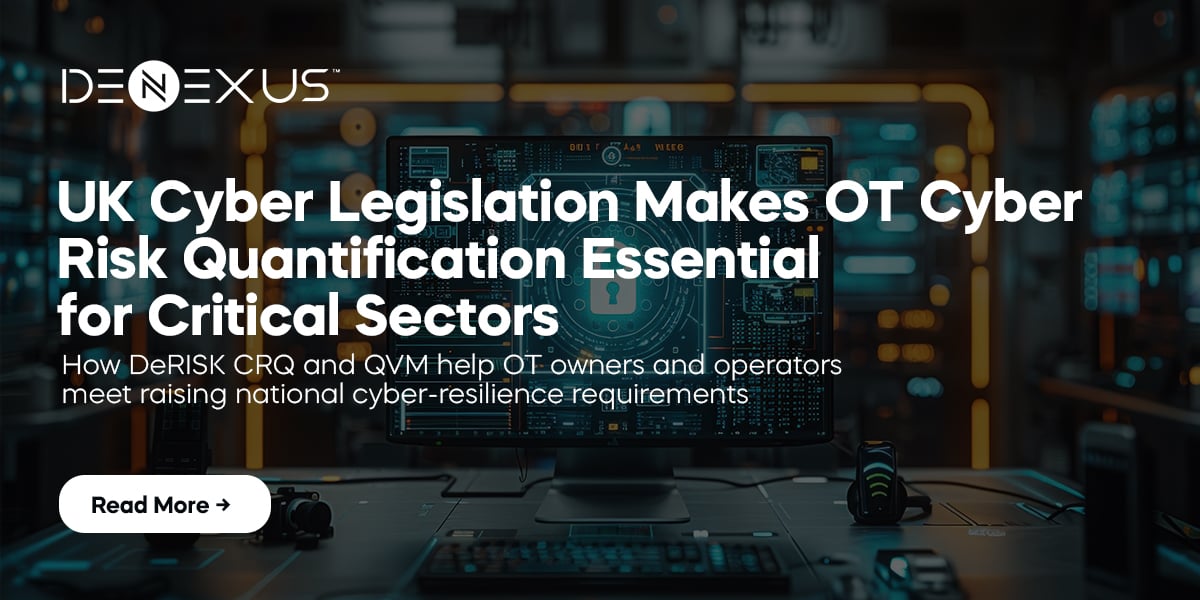Raising the Bar for National Cyber Resilience
The UK’s proposed Cyber Security and Resilience Bill introduce some of the strongest regulatory measures ever applied to essential public services. Healthcare, energy, transport, water providers, and data-centre operators will now face mandatory reporting duties, tougher enforcement powers, and minimum security baselines — including for suppliers in their critical supply chains.
For OT-dependent industries, the message is clear: traditional qualitative cybersecurity approaches are no longer sufficient. Boards, CISOs, and OT facility leaders must now quantify industrial cyber risk in financial, operational, and safety terms to meet regulatory expectations and protect mission-critical infrastructure.
What the New Law Requires
Organisations across healthcare, transport, energy, and water infrastructure will be required to:
- Report significant or potentially significant cyber incidents within 24 hours and submit full assessments within 72 hours.
- Bring designated suppliers under mandatory minimum OT security requirements.
- Implement evidence-based security controls and show measurable improvement over time.
- Prepare for turnover-based penalties and regulator-directed actions during national-security threats.
The legislation increases scrutiny over operational technology (OT) systems and cyber-physical services — areas where traditional IT-centric frameworks fall short.
Why OT Asset Owners Need Cyber Risk Quantification Now
Leaders in energy, transportation, water utilities, and healthcare must translate vulnerabilities into board-level cyber risk metrics. This requires industrial cyber risk quantification (CRQ) and quantified vulnerability management (QVM) to produce consistent, regulator-ready metrics.
- Cyber-Physical Impact Is Large-Scale and Measurable
New government figures reinforce the scale of OT cyber risk:
- A severe attack on critical national infrastructure could inflate UK borrowing by £30B+ (1.1% of GDP).
- The average cost of a significant cyber incident now exceeds £190,000, amounting to £14.7B annually.
In OT environments, these incidents do more than impact data — they disrupt physical service delivery, patient safety, grid reliability, and public health.
CRQ enables organisations to model expected loss (EAL), value-at-risk (VaR), and downtime-driven financial impacts, giving executives the evidence they need to justify security investment.
- Supply-Chain and MSP Risk Requires Quantification
The legislation extends obligations to third-party suppliers — including IT/OT providers, chemical suppliers for water treatment, diagnostics partners in healthcare, and vendors of smart-energy technologies.
Quantification is essential because:
- Third-party providers often bridge the IT/OT boundary.
- Hidden OT exposures (remote access, smart-device integrations, ICS maintenance contracts) often go unassessed.
- Boards must understand the probability-weighted financial impact of a supplier breach.
QVM provides transparent metrics for comparing supplier risk and ensuring regulatory compliance across the ecosystem.
- Minimum Security Baselines Demand Metrics, Not Opinions
Regulators will require measurable KPIs – not qualitative statements. OT operators must demonstrate:
- anomaly detection times
- patch-level compliance across ICS
- exposed OT services
- time to isolate infected control systems
- OT network segmentation performance
- supplier-level risk scores
Without quantified OT cyber risk metrics, organisations cannot prove readiness, resilience, or regulatory alignment.
- Physical Safety and Reliability Are Now Core Cyber Metrics
Because OT attacks disrupt physical processes — water quality, patient diagnostics, signalling systems, substations, smart EV-charging, etc. — regulators now expect organisations to quantify:
- service interruptions
- safety-of-life impacts
- backlog effects (e.g., hospital diagnostics)
- financial loss from outages
- cascading failures across critical systems
CRQ connects cyber events to real-world operational impact.
- Prioritisation and Resource Allocation Must Be Risk-Based
Industrial organisations must invest based on measurable impact — not instinct. CRQ enables leaders to prioritise:
- which OT assets drive the highest expected loss
- which vulnerabilities create the greatest financial exposure
- which supplier relationships represent disproportionate risk
- which controls deliver the highest ROI
This is essential for compliance, budgeting, insurance renewal, and long-term resilience planning.
The Path Forward — Full-Stack Industrial Cyber Risk Quantification
To meet the obligations of the UK Cyber Security and Resilience Bill, OT owners and operators must shift from traditional qualitative assessments to evidence-based cybersecurity grounded in financial metrics.
DeNexus’ DeRISK platform offers exactly that — a full-stack solution integrating:
- Cyber Risk Quantification (CRQ) for OT/ICS
- Quantified Vulnerability Management (QVM) across OT/ICS
- Expected loss (EAL), VaR, and incident probability modelling
- Board-level dashboards for regulators, auditors, and insurers
This approach enables energy grids and transport networks to justify budgets, meet regulatory expectations, and prove operational resilience with confidence.
Take Action Ahead of Regulatory Enforcement
The UK government has made it clear: organisations should not wait for enforcement deadlines.
Strengthening OT cyber resilience today reduces future compliance costs, protects operations, and positions organisations for insurance optimisation and regulator alignment.
Ready to turn complex OT vulnerabilities into board-level metrics?
Explore DeRISK Cyber Risk Quantification for OT


